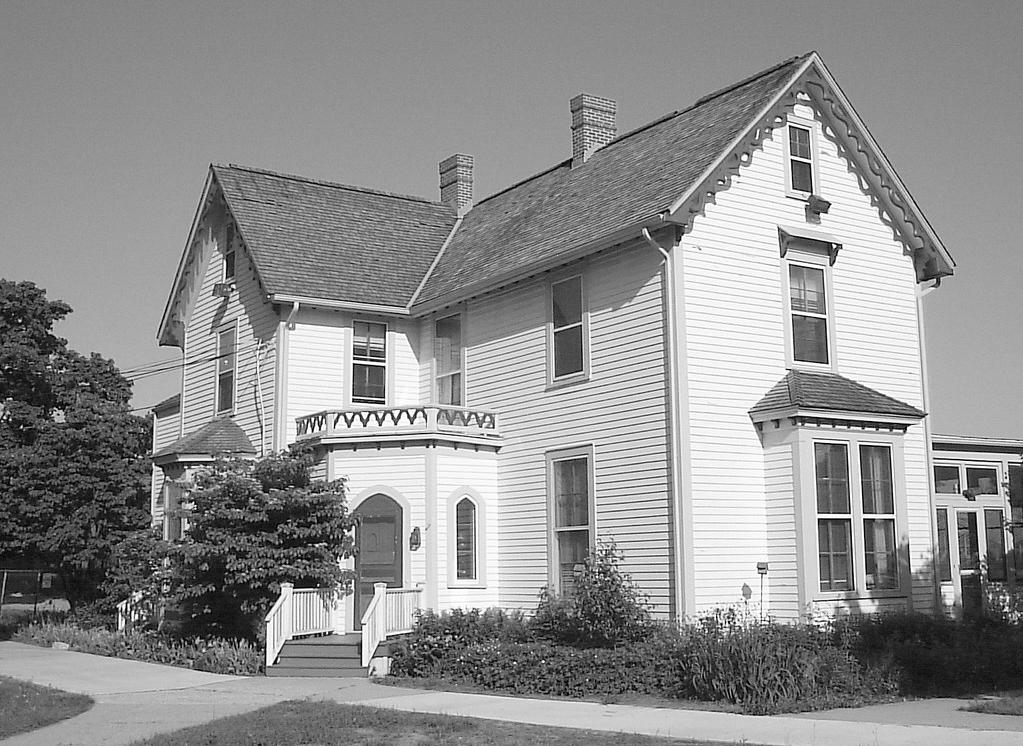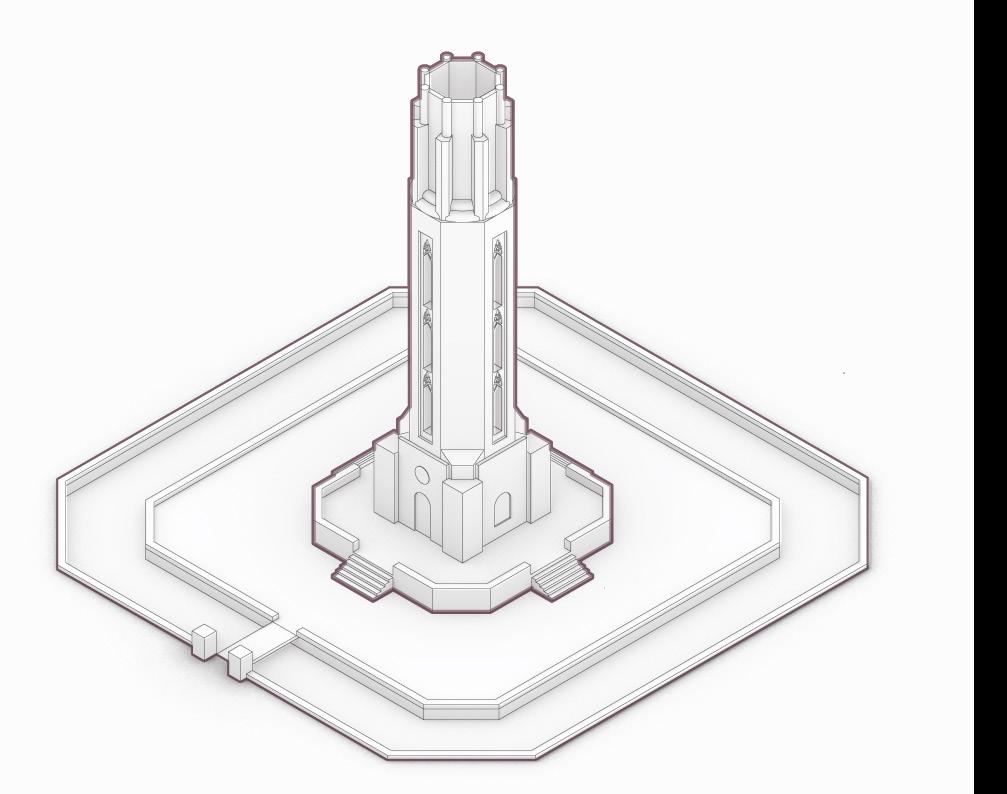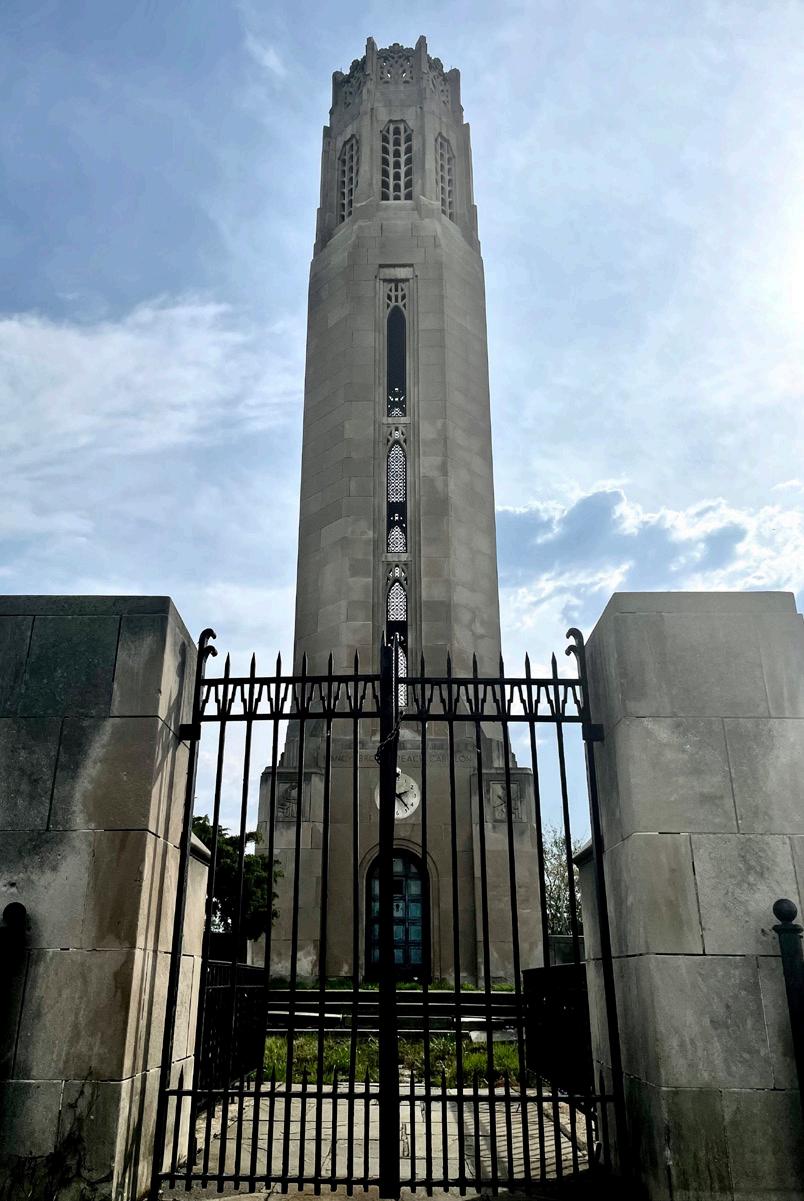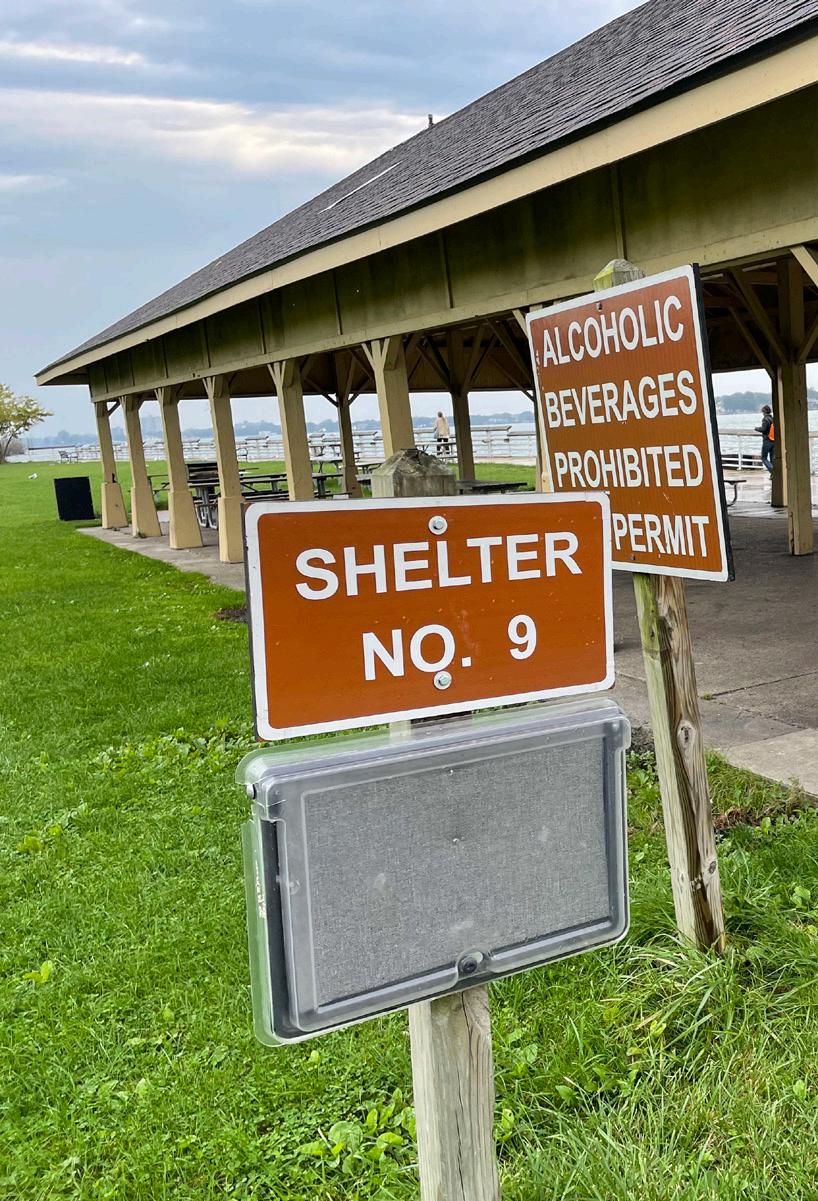BUILDING STORIES
ARE THE RESOURCES PRESENT FOR STRUCTURES EQUITABLY ALLOCATED?

ARE THE RESOURCES PRESENT FOR STRUCTURES EQUITABLY ALLOCATED?
abstract
Belle Isle has long existed as a nexus of culture and nature for the inhabitants of Detroit. Spread across the beautiful landscapes of the island, a constellation of structures invites visitor to a wide variety of programs and activities. While the most notable of these elements are historical buildings holding important collections like the Aquarium, and the Conservatory, monuments, memorials, recreational shelters, and other structures add to the historical significance of Belle Isle that granted its inclusion in the National Register of Historic Places. This diverse collection is subject to very uneven regimes of maintenance and care, and the always scarce allocation of resources has taken a toll on some of the most modest ones. This project celebrates the important legacy of historical structures that shape the unique nature of this park. By drawing Belle Isle’s building stories, the project traces a conversation between the existing and the imaginary, while highlighting latent stories about inaccessibility, historical dispute, and resource neglect. The project invites the visitor to engage by sharing distinct moments of their lived experience of the island.

Memorial Lighthouse
Program: Navigation/ Commemorative


Designed: Albert Kahn (1930)
Style: Art Deco
Accessibility: Closed to Public
Managed:
This lighthouse is one of the longest running the US as it heps the hundreds of freighters that pass through the Detroit River every day. Its beautifully carved exterior stands as a monument and important piece of infrastructure for freighter shipping in Detroit.
Building Stories
A- Anna Scripps Whitcomb Conservatory

B- Belle Isle Aquarium
C- Dossin Great Lakes Museum
D- The White House
E- Nancy Brown Peace Carillon
F- Belle Isle Casino
G- William Livingstone Memorial Lighthouse
H- Belle Isle Nature Center
I- Detroit Yacht Club
J- Shelters (general)
K- Comfort Stations (general)

Anna Scripps Whitcomb
Conservatory
Program: Nature Conservatory

Designed: Albert Kahn (1904)
Style: Beaux Arts
Attendance: 118,000 year
Managed: Belle Isle Conservancy
One of the oldest continually running conservatories in the U.S., the Belle Isle Conservatory was built in parallel with the aquarium next door. It carries the name of Anna Scripps Whitcomb, a philanthropist and avid gardener. The site boasts 13 acres of formal perennial gardens, seasonal floral beds, a lily pond garden and five sections of flora.

The design of the conservatory was inspired by Thomas Jefferson’s Monticello and the Crystal Palace in England. Originally the building was called the Horticulture Building, but it was later rededicated to Anna Scripps Whitcomb and received her donation of 600 orchids in 1955.
In 2009 the Belle Isle Conservancy was created through the merging of several organizations that were maintaining the island. Based on the Conservatory, the conservancy has always been primarily funded and maintained by volunteers and continues to be so.

Belle Isle Aquarium
Program: Aquarium/ Educational

Designed: Albert Kahn (1904)
Style: Beaux Arts
Attendance: 174,000 year
Managed: Belle Isle Conservancy
The Belle Isle Aquarium is the only aquarium in the state of Michigan and the oldest continually running aquarium in the country. Physically connected to the Conservatory, they opened the same day and the two share many programs and benefactors.


The north façade of the red brick building is covered with a beautiful Beaux Arts entrance made of in terracotta.
Accentuating it all, a decorated arch is topped with a keystone bearing a molded relief of Neptune and a dedication to the City of Detroit above. The interior of the building has a vaulted ceiling covered entirely in green tiles to make visitors feel they are underwater.
The aquarium has 60 exhibits with a total tank volume of 32,000 U.S. gallons and was home to over 1,500 fish of 146 species. The building was shortly closed off between 2005 and 2012 during the restructuring of Detroit’s finances. During that time, operation was shifted from the Detroit Zoological Society to the Belle Isle Conservancy. Today, he aquarium continues to fascinate old and young generations alike...

Program: Museum/ Archive

Designed: William Edward Kapp (1961)
Style: Mid Century-Modern
This museum is the premier maritime museum in metro-Detroit celebrating the regional vast shipping history. It features exhibits such as one of the largest collection of model ships in the world and a that passed by Belle Isle every day.
Attendance: 50,000 year
Managed: Detroit Historical Society


The museum is an outreach branch of the Detroit Historical Society on Belle Isle. Its main mission is to show the story of the Great Lakes, with emphasis on Detroit’s role in the maritime history of the region. To accomplish this the building is undergoing a $4.9 million renovation in an attempt to connect the building more directly with the rest of the island and the magnificent Detroit River.
Along the cove next to the museum, a new beach and kayak launch make the Detroit River accessible from the museum for the first time in its history. The museum will also be adding a riverfront patio space in order to make it a more enticing rental location. Once completed, it will be the only facility open to the public on the south side of the island providing additional capacity for events and

Program: Offices/ Park Programs

Designed: Unknown (1850)
The White House is the oldest standing structure on Belle isle but one of the least publicly engaged. The house was originally constructed as a summer residence for the family running the
Style: Gothic Revival
Accessibility: Closed to Public
Managed:
DNR

The structure has changed programs numerous times over the years from its original house. It has been a saloon /restaurant and the “Dairy Refreshment House”. It also held offices for the Detroit Garden Center, followed by use the Michigan Horticultural Society.
Today the DNR has offices inside the white house and plans are currently in motion to either fully renovate the building or move operation offices out of the structure entirely. This may lead to a future for the house as a historic museum for the island.

Carillon Tower
Program: Commemorative Monument

Designed: Clarence E. Day (1939)
The Carillon Tower is one of Belle Isle’s many commemorative built moments with this one highlighting a local journalist and writer Anne Louis Brown. She was a prolific columnist writing on womens issues in the early
Style: Neo-Gothic
Accessibility: Closed to Public
Managed: Local Volunteers


The tower was designed by Clarence E. Day, brother-in-law of James E. Scripps, the Detroit News publisher. The builder was Harlow A. Amsbary. The tower boasts a fully automatic bell music system inside a Neogothic tower and moat system. In 1970, the tower bells were stolen and the stained glass at the top broken. Soon after that the local wildlife destroyed many of the interior mechanisms that helped the bells chime.
Today, the carillon still chimes, but Detroit has been unable to amass the funds to fix the tower. The plant life is overgrown and its moat is filled with trash and algae. The new Oudolf Garden was recently finished in front of it solely through the help of passionate local volunteers who enlisted famous landscape architect Piet Oudolf to design a perennial (and didactic) garden in front of the tower.

Belle Isle Casino
Program: Event Space

Designed: Van Leyen & Schilling (1887)
Style: Beaux Arts
Yearly Rentals: 75 events
Managed: Belle Isle Conservancy
Originally constructed out of wood, the original Casino had no gabling on its interior, but rather was a wooden cathedral to leisure and relaxation on the island. Detroiters could grab a bite to eat there, or seek some shade. Others relaxed with a good book or gathered to play


In 1908 the wooden structure was torn down due to weathering and replaced with the current structure. It continues the tradition of serving as a meeting place and event spot, hosting everything from fairs to weddings. The casino was one of the most popular attractions on the island.
The new two -story building has beautiful tall towers framing the building’s four corners with encircling verandas and columns that allow guests to look out at Detroit and Canada over the pond. The building itself is not accessible to the public on a daily basis. Most Detroiters never see its interior since it is only used as a rental space today.

Memorial Lighthouse
Program: Navigation/ Commemorative


Designed: Albert Kahn (1930)
Style: Art Deco
Accessibility: Closed to Public
The all-marble, beautifully carved Art Deco exterior stands as a monument and relevant piece of infrastructure for freighter shipping. The lighthouse commemorates an influential media mogul, longstanding president of the Lake Carriers Association who led the construction of important infrastructures in the Great Lakes.
Managed:


Designed by Detroit-based architect Albert Kahn, the lighthouse punctuates north end of the island. The ornamentation on the exterior was done by influential Hungarian sculptor Geza Maroti, and it is the only lighthouse in the US entirely clad in marble.
AIA Detroit labeled it “an elegant ode to the possibilities of art deco applied to tall buildings.”
While the structure is still present and send white and red flash, the building is off limits to park guests due to a number of burglaries and vandalism. In 1980 and 1981, thieves broke into the lighthouse and stole two of the four lamps and spray painted the base. The City of Detroit erected a fence around the lighthouse to prevent further vandalism that serves as a reminder of the struggles to preserve historical buildings in the region.

Belle Isle Nature Center
Program: Educational

Designed: Ehresman Associates (2005)
Style: Modern
Attendance: 90,000 year
Managed: Detroit Zoological Society
Also known as the Belle Isle Nature Zoo, this structure is one of the most recently built pieces on the island. The center sits on the north east edge of the island’s unique wetmesic flatwoods forest, connected to the network of habitats and nature trails. It hold a variety of indoor and outdoor educational and conservation programs.


Inside the center, the exhibits hold a number of live species of reptiles, amphibians, insect, and even wild deer. Curators try to focus narratives towards the idea of local wildlife education and preservation. This way, children who come to visit, either with a school group or individually, have the chance to learn about the nature all around them in Michigan.
While ideal for school and family visits, the building restricted hours make it fairly inaccessible on a regular basis as it is only open from 10am-5pm Wednesday to Saturday. Open greenery and nature paths that surround it are luckily always open to visitors. Adjacent to the center on the north is the Lake Muskoday, and visitors can learn about its recent marshland restoration project.

Program: Private Social Club


Designed: George D. Mason (1868)
Style: Mediterranean Revival
Sitting on its own private island accessibly by only one guarded bridge, the Detroit Yacht sits as one of the last remaining and highly exclusive private social clubs. The club was originally founded in 1868 by local sailors. Over time the club swelled in membership to a staggering 3,000 in the 1920’s.
Members: ~ 800
Managed: Privately Owned/ Operated

The club itself is a palatial site that takes up the entirety of the island with boat slips, an Olympic swimming pool, a private restaurant, and several other amenities for patrons. Entrance to the island is only through one narrow bridge that prevents anyone except members and guests from entering. Today the club hosts roughly 800 members.
Membership is difficult to obtain, requiring a $390 fee and a number of signatures from current members. This process has made the club extremely exclusive and lacking any diversity. In recent years, the club has begun to diversify its membership. In 1971 the club inducted its first African American member, and in 2014 its first LGBTQ+ member.

Park Shelters
Program: Event Rental / Utility

Number: 20 Structures
State: Partial Disrepair

The numerous shelters on Belle isle are likely the most used structures on the island. Hundreds of Detroiters rent out their spaces for family celebrations, school events, and other group activities. Most consist of some large wooden canopy for cover,
Rentals: 629 Events
Managed: DNR


Many of the shelters have been on the island so long and are so intensely used that they have been listed on the historic building registry. Despite this, many of them have fallen into disrepair due to mismanagement in the last few decades, and several have been torn down. Not even the ones registered as historic structures have escaped this fate.
The Department of Natural Resources has indicated the need and will to restore and repair many of these shelters as art of the management plan. Most of the funding from the government has still been going toward more general island maintenance and upkeep, and the difficulties of the pandemic has hurt opportunities for the island to raise other funds.

Program: Nature Conservatory


Designed: Albert Kahn (1904)
Style: Beaux Arts
Attendance: 118,000 year
Managed: Belle Isle Conservancy
The number of comfort stations scattered around the island serve different purposes and idealize the principles of a certain era in the design of modest and functional facilities. Comfort stations are widely used and are an integral part of the built infrastructure on serving the public mission of the park.

There are seven historically significant comfort stations remaining on the island according to the national registry: Shadynook, Stone and Bear Pit comfort stations; the Bus Stop and Bath Launch; and Oakway and Woodside. A handful of newer stations have been built in recent years as well including the one at Sunset Point, in the South West end of the island.
Despite their constant use and historical significance, many of the stations are in dire need for repair. Since the DNR has taken over as caretaker for the buildings, marginal improvements have been seen and there are still ongoing projects for infrastructure and plumbing improvements at all eight neglected sites.